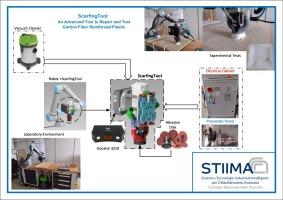ScarfingTool: An Advanced tool to repair Carbon Fiber Reinforced plastic
IF 2
Q3 ENGINEERING, ELECTRICAL & ELECTRONIC
引用次数: 0
Abstract
Carbon Fiber Reinforced Plastic (CFRP) is going to assume more and more importance in mechanical and aerospace engineering in the near future. This is due to its intrinsic high lightness and resistance, if compared to traditional metallic materials. CFRP is characterized by a proper production and repair technology. The tool showed in this paper is conceived to repair and verify the restoration of such kind of material. Its application is limited to the first part of the repair process: in jargon the scarfing operation, otherwise called “defect removal”. This operation is similar to a high-speed grinding.
For this reason, the designed tool can be easily applied to other contexts, such as sanding, polishing or deburring.
Basically, the ScarfingTool is composed by a high-speed electro-spindle and a 3D smart snapshot sensor. This tool is conceived to be as light as possible to be installed on a light collaborative robot. Moreover, its specific design assures great compliance that, as needed, can be regulated. A high efficiency suction inlet completes the tool and guarantees a clean environment during operation. The scarfing process has already been dealt with in [1] to which the interested reader is addressed.
This work is licensed under CC BY-SA 4.0. (https://creativecommons.org/licenses/by-sa/4.0)

ScarfingTool:修复碳纤维增强塑料的先进工具
在不久的将来,碳纤维增强塑料(CFRP)将在机械和航空航天工程中占据越来越重要的地位。这是因为与传统的金属材料相比,碳纤维增强塑料具有固有的高轻度和高抗性。CFRP 的特点是具有适当的生产和修复技术。本文中展示的工具就是为修复和验证此类材料的复原而设计的。它的应用仅限于修复过程的第一部分:用行话说,就是 "去疤痕",也就是 "去缺陷"。这种操作类似于高速打磨。因此,所设计的工具可以轻松应用于其他场合,如打磨、抛光或去毛刺。该工具设计得尽可能轻巧,可安装在轻型协作机器人上。此外,它的特殊设计确保了极高的顺应性,并可根据需要进行调节。高效率的吸入口完善了该工具,并保证了操作过程中的清洁环境。本作品采用 CC BY-SA 4.0 许可。(https://creativecommons.org/licenses/by-sa/4.0)
本文章由计算机程序翻译,如有差异,请以英文原文为准。
求助全文
约1分钟内获得全文
求助全文
来源期刊

HardwareX
Engineering-Industrial and Manufacturing Engineering
CiteScore
4.10
自引率
18.20%
发文量
124
审稿时长
24 weeks
期刊介绍:
HardwareX is an open access journal established to promote free and open source designing, building and customizing of scientific infrastructure (hardware). HardwareX aims to recognize researchers for the time and effort in developing scientific infrastructure while providing end-users with sufficient information to replicate and validate the advances presented. HardwareX is open to input from all scientific, technological and medical disciplines. Scientific infrastructure will be interpreted in the broadest sense. Including hardware modifications to existing infrastructure, sensors and tools that perform measurements and other functions outside of the traditional lab setting (such as wearables, air/water quality sensors, and low cost alternatives to existing tools), and the creation of wholly new tools for either standard or novel laboratory tasks. Authors are encouraged to submit hardware developments that address all aspects of science, not only the final measurement, for example, enhancements in sample preparation and handling, user safety, and quality control. The use of distributed digital manufacturing strategies (e.g. 3-D printing) is encouraged. All designs must be submitted under an open hardware license.
 求助内容:
求助内容: 应助结果提醒方式:
应助结果提醒方式:


